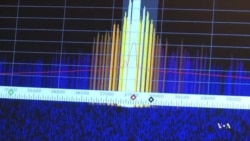LARGO, MARYLAND —
Experts say no one will really know what happened to Malaysia Airlines Flight 370 until the black box - the flight recorder - is retrieved. Time is running out because that flight recorder only emits an audible signal - a ping - for 30 days. The U.S. Navy has deployed one of its “pinger locators” to the Indian Ocean search area.
The sound is what it's all about. The sound coming from the black boxes - the flight data recorders that hold the key to what happened aboard Malaysia flight 370.
The locator will be towed more than 6,000 meters behind the Australian navy ship “Seahorse Standard.” It will be submerged two-thirds of the way to the bottom of the ocean. The locator sends sounds to an acoustic listening device and laptop aboard the ship.
“You might hear that tiny little chirp and say, ‘Did you hear something?’ And then we will listen more intently and try to fine-tune it,” said Paul Nelson, who is with Phoenix International, the company that manufacturers the pinger locators.
Fine-tuning it, means turning the boat around and repositioning the locator to pass over the area again. That maneuver takes eight hours. And time is ticking. The black box’s batteries can last longer than the reported 30 days, but the sound will eventually fade.
“The advertised shelf life for the pinger when it’s in the water is 30 days," said Jim Gibson, general manager at Phoenix Internatiomal. "We have individuals that have been on operations that have heard the pinger well beyond 45 days.”
The search is now centered several thousand kilometers southwest of Perth, Australia.
Following the locator, another Phoenix device could splash into the ocean. Once debris is identified on the ocean floor, a tool with a strong manipulator arm retrieves items and puts them into a box which is then hauled to the surface.
“It operates similar to what a helicopter would do," Paul Nelson said. "It hovers around the bottom and moves around place to place with a video camera.”
The machine, called Remora, assisted in the recovery of Air France Flight 447 - the aircraft was lost for five days but the black box was not found until two years later. Remora brought up the engines, computers, black boxes and more.
But it all takes time, in difficult conditions, including the effect of pressure at extreme ocean depths.
And, Remora is tiny in compared to the size of a typical debris field.
"If you don’t do it in time and in the right time, you miss items," Nelson said. "So it’s very slow and meticulous. Patience is required in this type of operation.”
As the search approaches three weeks, patience is not in abundance.
The sound is what it's all about. The sound coming from the black boxes - the flight data recorders that hold the key to what happened aboard Malaysia flight 370.
The locator will be towed more than 6,000 meters behind the Australian navy ship “Seahorse Standard.” It will be submerged two-thirds of the way to the bottom of the ocean. The locator sends sounds to an acoustic listening device and laptop aboard the ship.
“You might hear that tiny little chirp and say, ‘Did you hear something?’ And then we will listen more intently and try to fine-tune it,” said Paul Nelson, who is with Phoenix International, the company that manufacturers the pinger locators.
Fine-tuning it, means turning the boat around and repositioning the locator to pass over the area again. That maneuver takes eight hours. And time is ticking. The black box’s batteries can last longer than the reported 30 days, but the sound will eventually fade.
“The advertised shelf life for the pinger when it’s in the water is 30 days," said Jim Gibson, general manager at Phoenix Internatiomal. "We have individuals that have been on operations that have heard the pinger well beyond 45 days.”
The search is now centered several thousand kilometers southwest of Perth, Australia.
Following the locator, another Phoenix device could splash into the ocean. Once debris is identified on the ocean floor, a tool with a strong manipulator arm retrieves items and puts them into a box which is then hauled to the surface.
“It operates similar to what a helicopter would do," Paul Nelson said. "It hovers around the bottom and moves around place to place with a video camera.”
The machine, called Remora, assisted in the recovery of Air France Flight 447 - the aircraft was lost for five days but the black box was not found until two years later. Remora brought up the engines, computers, black boxes and more.
But it all takes time, in difficult conditions, including the effect of pressure at extreme ocean depths.
And, Remora is tiny in compared to the size of a typical debris field.
"If you don’t do it in time and in the right time, you miss items," Nelson said. "So it’s very slow and meticulous. Patience is required in this type of operation.”
As the search approaches three weeks, patience is not in abundance.









